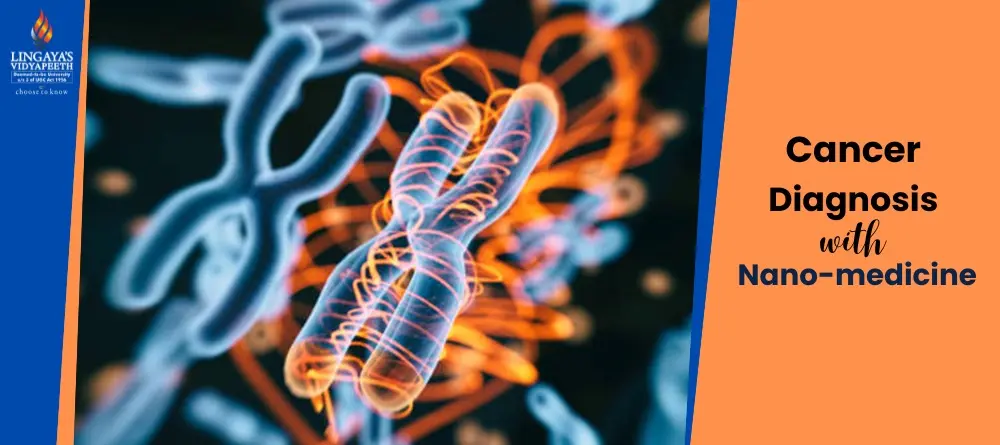
Home » How Does Nano-Medicine Integrate with Traditional Approaches to Cancer Diagnosis?

A class of illnesses characterized by intrinsic nanostructural defects (e.g., DNA problems) constitutes cancer. Therefore, treatments utilizing nanoscale structures and processes offer evident advantages.In light of this, the primary objective of Cancer Nanotechnology is to establish a platform wherein the most auspicious emerging concepts can be prominently showcased for researchers specializing in either nanotechnology or cancer research.Cancer Nanotechnology focuses on the most recent developments that arise at the convergence of nanotechnology and cancer research. Intentionally comprehensive interpretations of relationships with cancer encompass the following: prevention, treatment, diagnosis, and regulatory frameworks associated with these areas.Nanotechnology is broadly defined as the study of objects with characteristic length scales that are typically less than 500 nanometers. However, it also encompasses the manipulation of nanoscale processes, such as through the application of energy or different substances.
Present technique for diagnosing malignancy
Cancer is presently a leading cause of mortality on a global scale, and this trend is anticipated to continue as time passes. In order to diagnose cancer in a patient, low-resolution imaging techniques are typically combined with the detection and analysis.
of biomarkers. Typically, chemotherapy is employed as the therapeutic modality, with the specific target being the suspected form of tumor. Numerous ambiguities and constraints exist regarding this therapeutic and diagnostic procedure.
Identification and assessment
Particularly sensitive, selective, and able to identify multiple molecules, nano-enabled biosensors are well-suited for the detection of extracellular cancer biomarkers such as circulating tumor DNA, cancer-associated proteins, and extracellular vesicles. Additionally, the sensitive identification of cancer cells is facilitated by nanomaterial’s.
Perception in Vitro
There are now more options for early cancer diagnosis thanks to the identification of cancer-associated molecular changes in blood in several molecular locations, including the transcriptome, proteome, metabolome, and genome. High selectivity and sensitivity are possible for the enrichment and subsequent omics analysis of blood-circulating “cancer fingerprints” thanks to nanotechnology-enabled liquid biopsy diagnostic instruments. Compact gadgets or point-of-care systems can be created using proven manufacturing methods (such as lithography). These diagnostic instruments examine the existence, activity, or concentration of particular biological molecules in a sample of physiological fluid by means of biochemical reactions. These events can then be converted into detectable signals by means of optical, magnetic, or electronic techniques. Examples of these reactions include antigen-antibody binding, DNA fragment hybridization, and ligand adhesion to cell surface epitopes.
Visualization in Vivo
The sensitivity levels of the imaging techniques used today, such MRI, PET, and CT, are only good enough to identify tumors after hundreds of cancer cells have developed and perhaps spread. Now under research and translation, nanotechnology-based imaging contrast agents for traditional imaging modalities provide the capacity to greatly enhance and precisely target in vivo tumor detection. Furthermore, new imaging modalities not previously used for clinical cancer therapy and diagnosis, including as photo acoustic tomography (PAT), Raman spectroscopic imaging, and multimodal imaging, are being made possible by modern Nano scale imaging systems.
Assessing Reaction to Treatment
Measuring a patient’s reaction to targeted treatment, immunotherapy, or surgery as their disease advances is the cornerstone of accurate and predictive medicine. Preemptive clinical decision making (e.g., distinguishing therapeutic responders from non-responders), patient stratification for clinical trials, and treatment regimen optimization (e.g., therapeutic course correction, use of drug combinations, and fine-tuning drug doses) can all be made possible by accurate and pertinent disease monitoring. For this, there are three options: tissue biopsies, in vitro diagnostics, and in vivo imaging.
Although tissue biopsy is still the gold standard for identifying cancer, it is an intrusive method with limited spatial sampling capacity to adequately follow the evolution of the illness in relation to therapy. By using the tumor’s lost biological material—such as cells, DNA, and other cancer-specific biomolecules—circulating in blood over time, in vitro cancer detection and monitoring offers a more straightforward way to assess the response to therapy.
From
Dr. Swapnila Roy
School of Basic & Applied Sciences
December 8, 2023RECENT POSTS
CATEGORIES
TAGS
Agriculture Agriculture future AI Architecture artificial intelligence Bachelor of Commerce BA English BA Psychology BTech AIML BTech CSE BTech Engineering Business management career Career-Specific Education career guide career option career scope Civil engineering commerce and management Computer Science Computer science engineering Data science degree education Engineering Engineering students English Literature english program Fashion Design Fashion design course Higher Education Journalism journalism and mass communication law Law career Machine Learning Master degree mathematics MBA MBA specialization Mechanical Engineering Pharmacy Psychology Research and Development students
University Address: Nachauli, Jasana Road, Faridabad, Haryana
For Admissions :
Toll Free: 1800-120-4613
Mobile : 8447744303 | 8447744304 | 8447744306 | 8447744309
8700003974 | 8700003411 | 8700003749
Address: C-72, Second Floor, Shivalik, Near Malviya Nagar,
Above HDFC Bank, New Delhi 110017
Landline No. - 011-46570515 / 45138169 / 41755703
Mobile No. - +91-7303152412 / +91-7303152420 / +91-9311321952
Jagmani Kutir, Ground Floor, Road No-1, Rajeev Nagar,
Near Darbar Marriage Hall, Patna-800024, Bihar
Contact No: 9818352069/ 8130120095
Mail: kanhaiya@lingayasvidyapeeth.edu.in
Copyrights © 1998 - 2025 Lingaya's Vidyapeeth (Deemed To Be University). All rights reserved.
It is important to note that the following email IDs and domains are fraudulent and do not belong to our university.
LV only conducts physical/online verification of any document related to examination on the following email id: